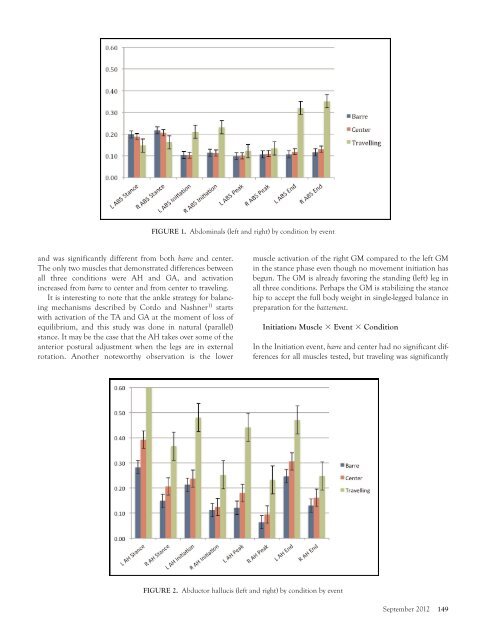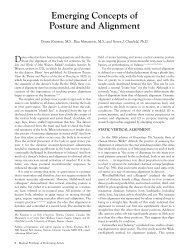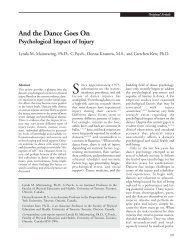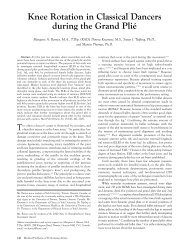Electromyographic Comparison of Grand Battement Devant at the ...
Electromyographic Comparison of Grand Battement Devant at the ...
Electromyographic Comparison of Grand Battement Devant at the ...
Create successful ePaper yourself
Turn your PDF publications into a flip-book with our unique Google optimized e-Paper software.
and was significantly different from both barre and center.<br />
The only two muscles th<strong>at</strong> demonstr<strong>at</strong>ed differences between<br />
all three conditions were AH and GA, and activ<strong>at</strong>ion<br />
increased from barre to center and from center to traveling.<br />
It is interesting to note th<strong>at</strong> <strong>the</strong> ankle str<strong>at</strong>egy for balancing<br />
mechanisms described by Cordo and Nashner 11 starts<br />
with activ<strong>at</strong>ion <strong>of</strong> <strong>the</strong> TA and GA <strong>at</strong> <strong>the</strong> moment <strong>of</strong> loss <strong>of</strong><br />
equilibrium, and this study was done in n<strong>at</strong>ural (parallel)<br />
stance. It may be <strong>the</strong> case th<strong>at</strong> <strong>the</strong> AH takes over some <strong>of</strong> <strong>the</strong><br />
anterior postural adjustment when <strong>the</strong> legs are in external<br />
rot<strong>at</strong>ion. Ano<strong>the</strong>r noteworthy observ<strong>at</strong>ion is <strong>the</strong> lower<br />
FIGURE 1. Abdominals (left and right) by condition by event<br />
muscle activ<strong>at</strong>ion <strong>of</strong> <strong>the</strong> right GM compared to <strong>the</strong> left GM<br />
in <strong>the</strong> stance phase even though no movement initi<strong>at</strong>ion has<br />
begun. The GM is already favoring <strong>the</strong> standing (left) leg in<br />
all three conditions. Perhaps <strong>the</strong> GM is stabilizing <strong>the</strong> stance<br />
hip to accept <strong>the</strong> full body weight in single-legged balance in<br />
prepar<strong>at</strong>ion for <strong>the</strong> b<strong>at</strong>tement.<br />
Initi<strong>at</strong>ion: Muscle � Event � Condition<br />
FIGURE 2. Abductor hallucis (left and right) by condition by event<br />
In <strong>the</strong> Initi<strong>at</strong>ion event, barre and center had no significant differences<br />
for all muscles tested, but traveling was significantly<br />
September 2012 149





